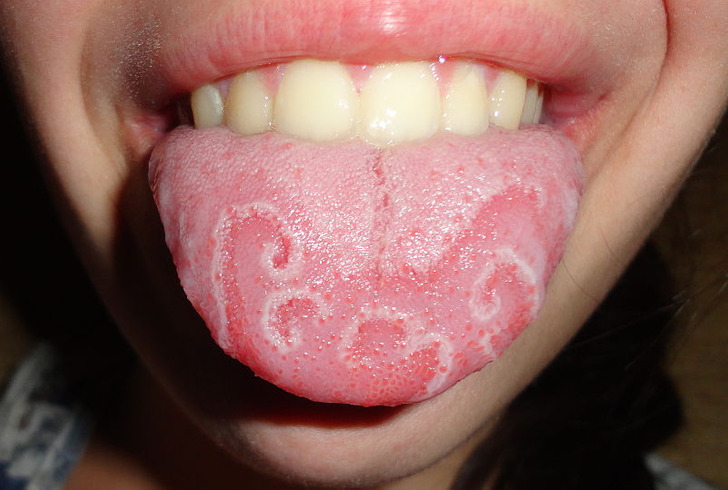There are many possible causes for white tongue, and in some cases, it comes with an unpleasant odor and mouth dryness. To get rid of it, sometimes you just need to brush your teeth. But what should you do if that doesn’t help?
❗ This article is for informative purposes only and can’t replace the advice of a specialist.
What white tongue is

The white film may cover the entire tongue, part of it, or appear as spots. At the same time, an unpleasant odor and taste in the mouth may appear. It looks as if there are small white hairs on the tongue’s surface. In fact, they are buds covered with organic particles, bacteria, and dead cells.
White plaque on the tongue (which can also be yellow) may appear for different reasons, like due to irritation or because of an infection. It usually disappears after several days. If the situation doesn’t change for several weeks, and it’s painful to eat and talk, it’s best to see a doctor.
It’s important to note that the plaque may not only be white. While a pink tongue is normal, a brown tongue means the person drinks too much coffee or tea. A yellow tongue means there’s something wrong with the liver, and a red tongue is a sign that the person lacks vitamin B.
Why the tongue becomes white

Usually, the tongue becomes white due to bacteria, leftover bits of food, or dead cells that get stuck in between the buds. Because of this, the buds may increase in size or become inflamed. This is how white spots on the tongue’s surface appear.
Sometimes, the plaque appears due to an illness. For example, the geographic tongue is also a condition where white spots appear on the tongue. It’s quite rare, and the causes are unknown, but the condition itself is often connected to eating foods that irritate the tongue. It may also be a reaction to stress, an illness, or hormonal changes.
Why white plaque appears on the tongue

There are some things that make the appearance of white plaque on the tongue more probable:
- Age
- Taking antibiotics (white-yellow plaque appearing when there’s a fungal infection in the mouth)
- A diet that’s lacking enough fruits, vegetables, vitamin B12, and iron
- A weak immune system
- Bad mouth hygiene
- Dental prosthetics or other objects that can damage the tongue
- Dehydration and mouth dryness
What piercings have to do with white tongue

Right after piercing the tongue, there might be some white film present. This happens because the number of bacteria on the tongue increases, and it’s normal. Antibacterial mouthwash will help you get rid of it. Plus, there might be a ring around the piercings, which is normal too, and it means the tissue is healing.
If the plaque appears due to an injury (including piercings), the healing should take around 1.5 weeks. You should avoid irritants, such as hot, spicy, or sour foods and drinks.
How to get rid of white tongue at home

- Practice good mouth hygiene.
- Drink enough water.
- Brush your teeth using a soft toothbrush.
- Use a mild fluoride toothpaste — one that doesn’t contain sodium lauryl sulfate.
- Use fluoride mouthwash.
- Brush your tongue or use a tongue scraper to remove the white coating.
- Drink cold drinks through a straw.
- Avoid food and drinks that are spicy, salty, acidic, or very hot in temperature.
Who to talk to if you’re worried about your white tongue

- Your dentist can help you remove the white film from the tongue and prescribe medications if needed.
- Your GP can diagnose the tongue, prescribe you certain medications and determine if the white tongue is an indicator of a more serious issue.
What do you do about white tongue?
Preview photo credit Genusfotografen (genusfotografen.se) & Wikimedia Sverige (wikimedia.se) / Wikimedia Commons, CC BY-SA 4.0, Martanopue / Wikimedia Commons, CC BY-SA 3.0
‘Outdated, punishing rules’ – Mom fights for son, 8, to keep his long hair despite schools rejecting him

Despite the fact that we all have mixed memories of school, we can all relate to the rules. This is a tumultuous moment of highs and lows.
While some rules, like the one against wearing jewelry to athletic events, make sense, it seems unnecessary to send someone home because they brought a certain soda or because they are wearing too much makeup. It also misses teaching opportunities for the kids involved.
The strict dress codes enforced by schools often clash with the times in children’s lives when they want to be different and express who they are.

For one mother and her child, these rules might have been excessive, and they might have kept an 8-year-old boy from getting an excellent education.
Farouk James of London, England, attracts the attention of model scouts due to his amazing hairstyle. He is currently working as a child model and has completed photo shoots in Italy and New York.
But his appearance has only made things difficult for him in the classroom; multiple institutions have rejected him due to the length of his hair.
Bonnie Miller, James’s mother, says she was told when her older brother was in school that his hair was too short.
Bonnie claims that Farouk’s father is from Ghana and that, in accordance with traditional traditions, his parents waited until he was three years old to cut his hair.

“At that point, he was attached— and so was I, to be honest— with his beautiful hair,” Bonnie stated to CBS News. “We kept the hair only.”
The family lives in the UK, where most schools have a policy against guys wearing long hair, even if girls are allowed to.
Bonnie claims that cutting a child’s hair violates their human rights.
“I will not give up trying to persuade governments to put legislation in place to protect children from these outdated, punishing rules,” his mother Bonnie wrote in an Instagram post.
“Despite the fact that Farok has done nothing wrong, you reject him! He will have to say farewell to his buddies when they are all accepted into the universities he so desperately wants to attend.
Because of this, Bonnie even started a Change.org petition to make hair discrimination illegal in the UK.
“We’re assembling a real team and dubbed it the Mane Generation,” Bonnie said. “We are going to fight this until these rules are changed. It also spreads over the entire world, not only the United Kingdom.
Farouk’s mother has an Instagram account that boasts over a quarter of a million followers, showcasing his lively nature and role as a child model.

They still get hate mail, though, despite all the love and support he gets online. Bonnie stated she received a lot of negative comments after discussing the family’s search for a school that will welcome Farouk and his hair on the well-known U.K. TV morning show “This Morning.”
“This is mental health week, so I’m surprised to be receiving lots of negative comments about Farouk’s hair,” Bonnie said in May of last year.
“Farouk refuses to cut his hair to appease people; it is a God-given feature of him, and he does not keep it long at my request.”
Bonnie argues that the clothing regulations for boys and girls in schools are outdated and often discriminatory because many schools prohibit braids and dreadlocks.
The mother vows that she will never give up on gaining acceptance for Farouk, his hair, and all the other children who encounter discrimination because they want to display their cultural heritage and identity.
In 2022, it will not be acceptable for people in charge of our children’s education to turn away a student because of the color of their hair. Farouk’s hair is an essential component of who he is. These rules should be prohibited.



Leave a Reply